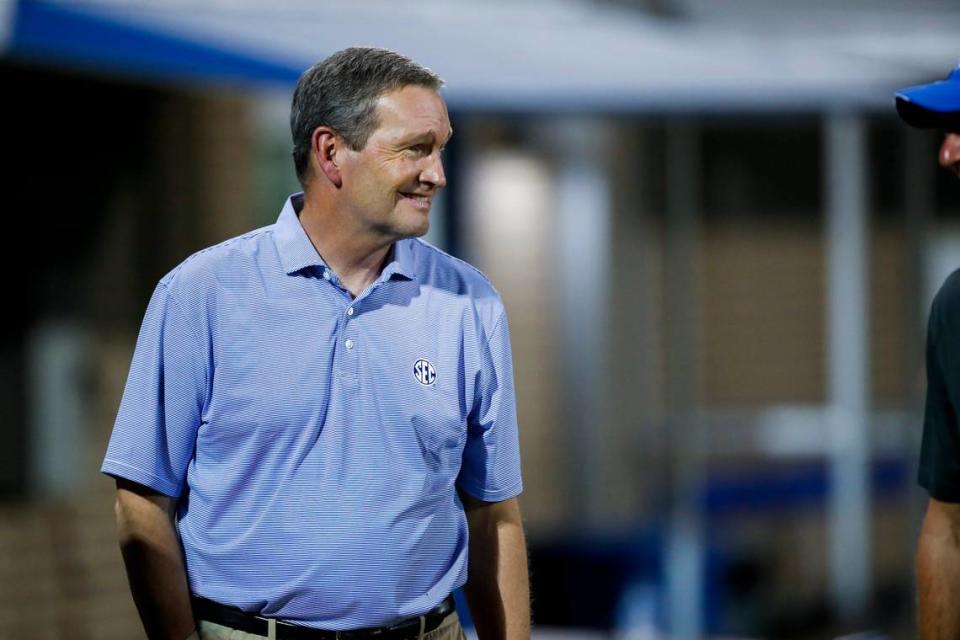Mitch Barnhart explains what the most recent round of conference realignment means for UK
- Oops!Something went wrong.Please try again later.
Conference realignment is again at the forefront of the changing college sports landscape.
Recent months have seen significant movement across the country for NCAA Division I schools, with college football acting as the driving force behind widespread changes in conference affiliation set to take effect next summer.
The Pac-12 quartet of Oregon, Southern California, UCLA and Washington are leaving for the Big Ten. Former Pac-12 schools California and Stanford are set to join SMU (currently of the American Athletic Conference) as new members of the ACC.
The Big 12 — which already welcomed BYU, Central Florida, Cincinnati and Houston this offseason — will add Arizona, Arizona State, Colorado and Utah next year.
Of course, departing Big 12 members Oklahoma and Texas will be joining Kentucky in the SEC, a high-profile change that will push the conference to 16 members.
And that’s only a brief summary of the major conference changes set to begin next school year.
When speaking at the Lexington Forum this month as part of a moderated conversation, UK athletics director Mitch Barnhart described the factors behind these changes.
“Conference realignment, there’s all sorts of reasons for it,” Barnhart said. “Some of it’s driven out of media packages, some of it’s driven out of competitiveness.”
To illustrate just how chaotic conference realignment has become, take a look at the Sept. 9 college football contest between Oklahoma and SMU.
This year, that game was a Big 12 versus American Athletic Conference contest.
In 2027, when those two teams are scheduled to complete their home-and-home series, it will be an SEC versus ACC game.
And who knows what additional conference realignment will occur between now and then?
(In 2024, the SEC will play an eight-game football schedule without divisions. Barnhart said conversations are ongoing for what the SEC football schedule will look like for the 2025 season and beyond.)
But something that’s been paramount in the discourse following this recent round of realignment is the effects it will have on travel for student-athletes, in particular for non-football sports.
From men’s basketball to volleyball, concerns have been raised about the logistics of traveling across the country for weeknight games.
In early August, former Kentucky and Louisville (and current St. John’s men’s basketball head coach) Rick Pitino was one of several head coaches to criticize this new-look landscape.
Doesn't it make more sense for football to break away to separate leagues and allow the rest of the sports to compete regionally? Rivalries remain n minor sports don't spend half their day looking for bad food at airport restaurants!!!
— Rick Pitino (@RealPitino) August 6, 2023
Barnhart discussed the academic challenges posed to student-athletes with long-distance trips for games.
“If we’re flying (student-athletes) across the country from East Coast to West Coast to compete, they compete and then they’re having to come home, I don’t know that that’s in the best interest of our student-athletes,” Barnhart said.
During a question-and-answer period with guests during his Lexington Forum appearance, Barnhart was directly asked if this current model of college sports is sustainable into the future.
“Financial sustainability, that’s one issue. Academic, educational sustainability, that’s another issue. Socially, hanging in there socially with it and trying to figure out how to make it all work, that’s another issue,” Barnhart said. “There’s multiple issues in terms of sustaining it.”

Logistics for Kentucky with Oklahoma, Texas joining SEC
Kentucky shouldn’t be substantially affected by the additions of Oklahoma and Texas to the SEC, at least from a travel aspect.
The farthest SEC outpost from Lexington (based on miles away via car trip) is currently Texas A&M in College Station, Texas, at 973 miles.
Oklahoma (851 miles) checks in below that number while Texas (1,069 miles) is slightly above.
This pales in comparison to the new reality of schools like Oregon and Rutgers (separated by more than 2,900 miles by car) that now have to play each other in a variety of sports, many of them being non-revenue sports.
When discussing the additions of Oklahoma and Texas to the SEC, Barnhart pointed out that these two schools already fit within the existing SEC footprint.
“A trip to Austin, Texas, is literally 10 minutes longer flight time than it is to go to Texas A&M for us,” Barnhart said. “To go to Norman, Oklahoma, is the exact same amount of time as it is to get to Texas A&M for us in a charter, on our flights. So we’re not extending the boundaries of where we’re competing, which is really, really important for me.”
Barnhart praised SEC commissioner Greg Sankey for his efforts to maintain the conference’s footprint.
“We added two schools in this expansion that were going to go someplace,” Barnhart said. “Having them in our footprint, having them in our competitive environment … It makes it competitively hard. It, obviously, makes us stronger as a whole. It gives us strength as a conference to be able to go publicly about our conference television packages and things like that, which is clearly what is funding most of our programs.”
Does NIL help or hurt recruiting in college sports? Kentucky AD Mitch Barnhart weighs in.

